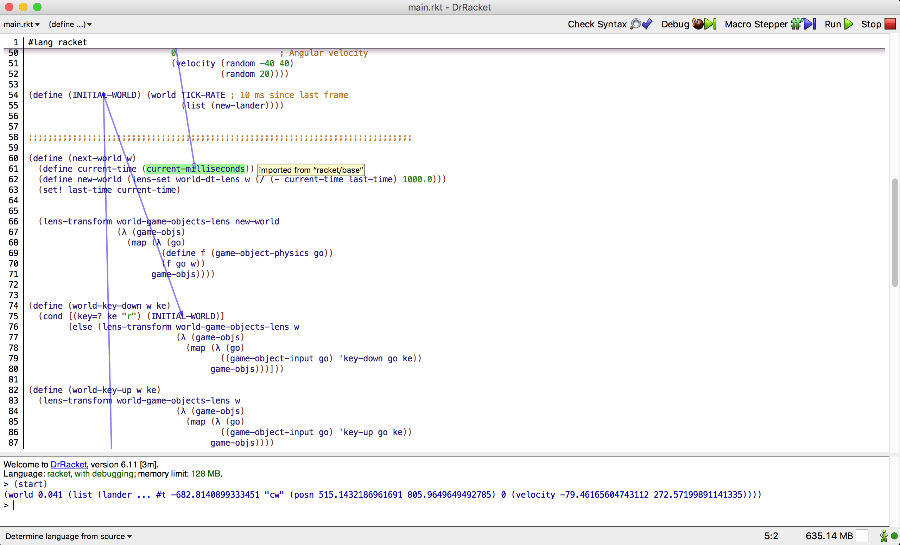Racket Reading Group - Session 1 and Session 2
This is a continuation of the Racket reading group.
The first session got us off the ground. Everyone was able to buy the book and cover the first 4.5 chapters.
Apart from covering logistics of the reading group like agreeing on a pace. We covered some of the basics of Dr. Racket1. We showed off a few of the concepts that occurred in the first several chapters of the book2. The next chapter we agreed to read covers an introduction to the big-bang macro.
We finished up the meeting by showing off a pokemon themed missile defense game made by someone in the group during a college class. It gave us an idea of the types of games we could create with Racket. Very cool stuff.
Here are some things that people liked from this session.
Debugging with Dr. Racket
Dr. Racket has some great features for new developers to track errors in their code. When the Racket VM crashes with an error we are presented with a great visual display pointing to exactly where the error occurred.
I personally like this feature a lot. Even as an avid user of Emacs I appreciate when something is done well. I think VSCode, Webstorm, Visual Studio, etc. have enough information available to them through stack traces for rendering helpful feedback overlays.
Now, I feel obligated to mention that errors in Emacs are difficult to debug. For some reason the stack traces are un-helpful and cryptic with pointing out errors. It isn’t easy for me to determine if this is because of Geiser mode or if Dr. Racket is doing something automagically behind the scenes.
Pointing out code identifiers is cool in Dr. Racket as well. This helps beginners determine where identifiers come from.

If expressions
We talked a bit about the difference between expressions and statements. I offered some insight into how nice expressions are to work with especially in a language like Haskell. Some people found it odd that you always need to provide an else value.
In the example below, the variable if-result will be assigned the value of 1.
(define if-result (if #t 1 2))Macros
We spent a few minutes talking about macros and how they generate code for us. A prime example for us is the struct macro. Once the semantics were understood it feels less magical from where certain accessor functions come from. We pointed out that structs are a little cumbersome to use with what we know about them from our brief introduction. Looking ahead in the material we see there are solutions to these problems but we haven’t gotten there yet.
Renaming the field members of a struct can be cumbersome. For this task we found it helpful to use Dr. Racket.
Session 2
Our goal for session 2 was to cover chapter 5 and chapter 6. These two chapters cover an introduction to the big-bang macro with a small landing space craft and a snake game.
We didn’t quite cover all of the two chapters. We noticed that the snake game had pieces we needed to define ourselves. We decided that the group should spend another week working through the snake game and making our own custom tweaks to any game of our choosing.